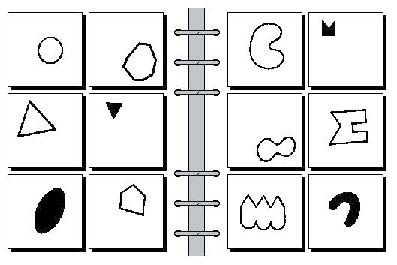

Not all patterns are of this form.
Where classifications are based on relationships between values, there is no dependency between classes and absolute values.
So, no reason for examples of a particular class to gather in any particular part of the space.
Popular answers:
What are the significant patterns?
How could they be identified and modeled?
13 2 2 3 8 2 2 1 2 4 --> 4 8 3 6 4 6 2 8 3 8 1 --> 5 12 1 5 2 3 3 3 2 3 1 --> 4 13 4 13 3 8 2 8 1 8 3 --> 5 9 3 10 1 11 2 12 1 13 4 --> 7 10 4 10 3 1 3 1 4 10 2 --> 5 13 4 11 4 11 3 13 4 13 4 --> 5 9 2 4 2 5 2 13 2 10 2 --> 6 7 4 12 4 12 2 4 2 12 1 --> 4 13 2 8 2 1 3 1 3 1 4 --> 4 10 3 10 1 5 2 13 2 10 2 --> 4 13 4 3 4 4 1 3 4 3 4 --> 4 11 2 8 4 4 4 4 2 4 4 --> 4 11 3 11 4 13 1 13 1 13 3 --> 5 2 3 2 1 2 1 2 2 1 4 --> 9 8 2 2 2 9 2 11 2 13 2 --> 6
Input variables are in twos, where the first number is the card value and second number represents the suit.
The class variable is the rank of the hand in poker.
pair < threes < full house < run < etc.
13 2 2 3 8 2 2 1 2 4 --> 4 8 3 6 4 6 2 8 3 8 1 --> 5 9 2 4 2 5 2 13 2 10 2 --> 6 9 3 10 1 11 2 12 1 13 4 --> 7
Should we expect examples of a particular rank to clump together in the data space?
BACON is provided with knowledge of mathematical relationships.
It then searches through the space of possible compositions of those relationships, testing to see how well each one predicts the data.
This states that the squares of the periods of planets are proportional to the cubes of the mean radii of their orbits.
(In other words, it states that the square of the year is proportional to the cube of the average distance from the sun.)

is constant.
It then constructs increasingly complex formulae using division and multiplication operators:
Planet y d y/d (y/d)/d ((y/d)/d)y (((y/d)/d)y)/d Mercury 0.24 0.39 0.62 1.61 0.39 1.00 Venus 0.61 0.72 0.85 1.18 0.72 1.00 Earth 1.00 1.00 1.00 1.00 1.00 1.00 Mars 1.88 1.52 1.23 0.81 1.52 1.00 Ceres 4.60 2.77 1.66 0.60 2.76 1.00 Jupiter 11.86 5.20 2.28 0.44 5.20 1.00 Saturn 29.46 9.54 3.09 0.32 9.54 1.00 Uranus 84.01 19.19 4.38 0.23 19.17 1.00 Neptune 164.80 30.07 5.48 0.18 30.04 1.00 Pluto 248.40 39.52 6.29 0.16 39.51 1.00 T.Beta 680.00 77.22 8.81 0.11 77.55 1.00
Process stops once a constant value is found.
Provided that the search space used is appropriately customised, the program is guaranteed to succeed, i.e., to `discover' whatever law applies.
Hence, these methods are describes as doing machine dicovery.
the big problem is that it requires relationships and variables to be configured so as to ensure that the search succeeds.
This is easy enough where the make-up of the target relationship is known.
However, where the aim is to discover regularities of an unknown form, it may be much more challenging.
A prominent approach here is the structure-mapping framework of Gentner and colleagues.
The key idea in this is that the strength of analogy between two concepts depends on similarities in their relational structure.


This will only work if the space contains a satisfactory model.
So we need to know quite a bit about the solution in order to find it this way.
In simple cases, there may be no difficulty. But in realistic scenarios, it may be very difficult to identify appropriate domain knowledge.